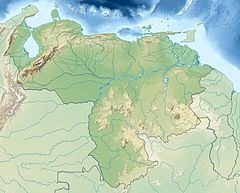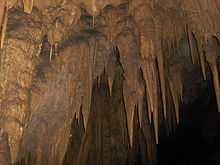70:
244:
77:
54:
261:
313:
The
National Park was created in 1975 to conserve the cave and the forest ecosystem where the oilbirds feed. The altitude of the national park is 900–2,340 m (2,950–7,680 ft). There are 367 species of bird in the national park, which has been designated an
284:
word for one who shrieks or cries, because of their characteristic sound. They are brown with black and white spots, have a long tail and bristles around their beak. They measure around 48 cm (19 in) in length, including the tail. The
251:
The cave is a limestone cavern over 10 km (6.2 mi) long, with a number of large chambers and spectacular rock formations. The temperature inside the cave generally remains near 19 °C (66 °F) and the humidity at 100%.
298:
The most important daily event in the park occurs in the evening, as dusk falls, when the birds exit the cave in great flocks, in search of food. Visitors are able to view the birds leaving the cave.
377:, in Germany, has been popularly known for 60 years as the "Humboldt Museum" (from 1949 to 2009). This other Museum in Venezuela has nothing to do with the German museum located in Berlin.
69:
520:
122:
888:
642:
878:
467:
589:
513:
873:
832:
903:
898:
652:
809:
554:
685:
868:
506:
761:
529:
274:
Oilbirds are fruit-eating birds that live within the first section of the cave; they leave at night in search of food. The
Spanish name
804:
799:
20:
794:
718:
541:
584:
579:
675:
647:
374:
39:
893:
627:
559:
837:
680:
667:
352:
Near to the cave entrance is the
Humboldt Museum. It offers information about the cave, the national park, the oilbird (
335:
883:
713:
549:
766:
863:
824:
776:
738:
728:
703:
695:
657:
24:
637:
619:
323:
632:
604:
424:
Die Reise in die Äquinoktial-Gegenden des Neuen
Continents in den Jahren 1799, 1800, 1801, 1802, 1803 und 1804
609:
594:
569:
814:
574:
490:
437:
212:
842:
784:
756:
746:
723:
708:
415:
Personal
Narrative of Travels to the Equinoctial Regions of the New Continent During the Years 1799-1804
243:
227:
599:
564:
442:
295:, formed by excrement and vomited seeds, which provide the basic nutrients for the cave's ecosystem.
789:
315:
485:
319:
180:
461:
307:
281:
405:
331:
193:
231:) which live in the cave belonged to a species unknown to science. Humboldt named the
857:
43:
53:
232:
498:
137:
124:
533:
100:
402:
Le voyage aux régions equinoxiales du
Nouveau Continent, fait en 1799-1804
322:, several other resident birds fall into this category, for example the
269:
216:
205:
96:
201:
110:
19:
This article is about the
Venezuelan cave and national park. For the
260:
292:
259:
242:
208:, Venezuela. It has as its centerpiece a large limestone cave.
502:
426:, Alexander von Humboldt, Aimé Bonpland (Vienna, 1827, etc.)
446:
76:
200:) is located 12 km (7.5 mi) from the town of
334:. The national park is part of Cordillera de Caripe
823:
775:
737:
694:
666:
618:
540:
176:
161:
153:
116:
106:
92:
32:
341:Zona Protectora Macizo Montañoso del Turimiquire
235:, nocturnal species after the town of Caripe.
514:
353:
339:
306:The cave was designated as Venezuela's first
286:
275:
220:
8:
291:produce an organic layer in the cave called
84:Location of Cueva del Guácharo National Park
590:Juan Crisóstomo Falcón, Sierra de San Luis
521:
507:
499:
29:
338:(AZE) site, along with another IBA, the
389:
366:
280:is onomatopoeic, and comes from an old
491:Caripe.net - Spanish site about Caripe
466:: CS1 maint: archived copy as title (
459:
318:(IBA). Although the oilbird is not an
555:Ciénagas de Juan Manuel/del Catatumbo
215:, who realised that the thousands of
7:
91:
889:Protected areas established in 1949
198:Parque Nacional Cueva del Guácharo
14:
879:Important Bird Areas of Venezuela
638:General Cruz Carrillo/Guaramacal
375:Natural History Museum of Berlin
211:The cave was visited in 1799 by
75:
68:
52:
33:Cueva del Guácharo National Park
874:Birdwatching sites in Venezuela
358:), and Alexander von Humboldt.
160:
105:
904:Tourist attractions in Monagas
899:Natural monuments of Venezuela
600:Tirgua General Manuel Manrique
1:
560:Cueva de la Quebrada del Toro
486:Guácharo Cave spelunking site
336:Alliance for Zero Extinction
225:in Spanish; scientific name
869:National parks of Venezuela
643:General Juan Pablo Peñaloza
190:Guácharo Cave National Park
920:
440:(2015). . Downloaded from
267:
18:
16:National park in Venezuela
747:Mariusa/Delta del Orinoco
404:, Alexandre de Humboldt,
63:
51:
37:
324:Venezuelan flowerpiercer
833:Archipiélago Los Roques
810:Serranía de la Neblina
438:BirdLife International
354:
340:
328:Diglossa venezuelensis
287:
276:
265:
248:
221:
213:Alexander von Humboldt
197:
165:May 27, 1975
25:Cueva de los Guácharos
21:Colombian Natural park
843:Laguna de la Restinga
417:(London, 1814, etc.);
263:
246:
228:Steatornis caripensis
138:10.19989°N 63.63968°W
894:Geography of Monagas
686:Río Viejo San Camilo
408:(Paris, 1807, etc.);
790:Caura National Park
719:Laguna de Tacarigua
316:Important Bird Area
177:Governing body
143:10.19989; -63.63968
134: /
884:Caves of Venezuela
762:Península de Paria
752:Cueva del Guácharo
320:endangered species
266:
249:
851:
850:
805:Parima Tapirapecó
800:Jaua-Sarisariñama
777:Region of Guayana
676:Aguaro-Guariquito
542:Western Venezuela
308:National Monument
186:
185:
107:Nearest city
911:
864:IUCN Category II
648:Sierra La Culata
620:Venezuelan Andes
585:Sierra de Perijá
523:
516:
509:
500:
495:
473:
471:
465:
457:
455:
454:
445:. Archived from
435:
429:
422:
413:
400:
394:
378:
371:
357:
343:
332:Venezuelan sylph
290:
279:
224:
172:
170:
149:
148:
146:
145:
144:
139:
135:
132:
131:
130:
127:
79:
78:
72:
56:
30:
919:
918:
914:
913:
912:
910:
909:
908:
854:
853:
852:
847:
819:
795:Duida-Marahuaca
771:
733:
690:
662:
628:Chorro El Indio
614:
580:Médanos de Coro
536:
527:
493:
482:
477:
476:
458:
452:
450:
443:"Archived copy"
441:
436:
432:
420:
411:
398:
395:
391:
386:
381:
372:
368:
364:
350:
348:Humboldt Museum
304:
272:
258:
247:The cave inside
241:
168:
166:
142:
140:
136:
133:
128:
125:
123:
121:
120:
88:
87:
86:
85:
82:
81:
80:
59:
47:
28:
17:
12:
11:
5:
917:
915:
907:
906:
901:
896:
891:
886:
881:
876:
871:
866:
856:
855:
849:
848:
846:
845:
840:
838:Cerro El Copey
835:
829:
827:
821:
820:
818:
817:
812:
807:
802:
797:
792:
787:
781:
779:
773:
772:
770:
769:
764:
759:
754:
749:
743:
741:
739:Eastern Region
735:
734:
732:
731:
726:
721:
716:
711:
706:
700:
698:
696:Central Region
692:
691:
689:
688:
683:
681:Santos Luzardo
678:
672:
670:
664:
663:
661:
660:
655:
650:
645:
640:
635:
630:
624:
622:
616:
615:
613:
612:
607:
602:
597:
592:
587:
582:
577:
572:
567:
562:
557:
552:
546:
544:
538:
537:
530:National parks
528:
526:
525:
518:
511:
503:
497:
496:
488:
481:
480:External links
478:
475:
474:
430:
428:
427:
418:
409:
388:
387:
385:
382:
380:
379:
365:
363:
360:
349:
346:
303:
300:
268:Main article:
257:
254:
240:
237:
184:
183:
178:
174:
173:
163:
159:
158:
155:
151:
150:
118:
114:
113:
108:
104:
103:
94:
90:
89:
83:
74:
73:
67:
66:
65:
64:
61:
60:
57:
49:
48:
38:
35:
34:
15:
13:
10:
9:
6:
4:
3:
2:
916:
905:
902:
900:
897:
895:
892:
890:
887:
885:
882:
880:
877:
875:
872:
870:
867:
865:
862:
861:
859:
844:
841:
839:
836:
834:
831:
830:
828:
826:
822:
816:
813:
811:
808:
806:
803:
801:
798:
796:
793:
791:
788:
786:
783:
782:
780:
778:
774:
768:
765:
763:
760:
758:
755:
753:
750:
748:
745:
744:
742:
740:
736:
730:
727:
725:
722:
720:
717:
715:
714:Henri Pittier
712:
710:
707:
705:
702:
701:
699:
697:
693:
687:
684:
682:
679:
677:
674:
673:
671:
669:
665:
659:
656:
654:
653:Sierra Nevada
651:
649:
646:
644:
641:
639:
636:
634:
631:
629:
626:
625:
623:
621:
617:
611:
608:
606:
603:
601:
598:
596:
593:
591:
588:
586:
583:
581:
578:
576:
573:
571:
568:
566:
563:
561:
558:
556:
553:
551:
550:Cerro Saroche
548:
547:
545:
543:
539:
535:
531:
524:
519:
517:
512:
510:
505:
504:
501:
492:
489:
487:
484:
483:
479:
472:on 25/08/2015
469:
463:
449:on 2007-07-10
448:
444:
439:
434:
431:
425:
419:
416:
410:
407:
406:Aimé Bonpland
403:
397:
396:
393:
390:
383:
376:
370:
367:
361:
359:
356:
347:
345:
342:
337:
333:
329:
325:
321:
317:
311:
309:
301:
299:
296:
294:
289:
283:
278:
271:
262:
256:Guácharo bird
255:
253:
245:
238:
236:
234:
230:
229:
223:
218:
214:
209:
207:
203:
199:
195:
191:
182:
179:
175:
164:
156:
152:
147:
119:
115:
112:
109:
102:
98:
95:
71:
62:
55:
50:
45:
44:national park
41:
40:IUCN category
36:
31:
26:
22:
751:
494:(in Spanish)
451:. Retrieved
447:the original
433:
423:
414:
412:(in English)
401:
392:
369:
351:
327:
312:
305:
302:Conservation
297:
273:
250:
226:
210:
189:
187:
729:San Esteban
658:Tapo-Caparo
421:(in German)
399:(in French)
233:frugivorous
169:1975-May-27
162:Established
141: /
117:Coordinates
858:Categories
668:Los Llanos
453:2014-04-01
384:References
330:) and the
129:63°38′23″W
126:10°12′00″N
58:Cave mouth
767:Turuépano
595:Terepaima
570:El Guache
534:Venezuela
310:in 1949.
288:guácharos
282:Castilian
222:guácharos
181:INPARQUES
101:Venezuela
825:Offshore
815:Yapacana
704:El Ávila
575:Morrocoy
462:cite web
355:guácharo
277:guácharo
264:Oilbirds
239:The cave
217:oilbirds
93:Location
785:Canaima
757:Mochima
724:Macarao
709:Guatopo
633:El Tamá
605:Yacambú
270:Oilbird
206:Monagas
194:Spanish
167: (
157:627 km²
97:Monagas
610:Yurubí
565:Dinira
202:Caripe
111:Caripe
23:, see
362:Notes
293:guano
468:link
373:The
188:The
154:Area
42:II (
532:of
860::
464:}}
460:{{
344:.
204:,
196::
99:,
522:e
515:t
508:v
470:)
456:.
326:(
219:(
192:(
171:)
46:)
27:.
Text is available under the Creative Commons Attribution-ShareAlike License. Additional terms may apply.



